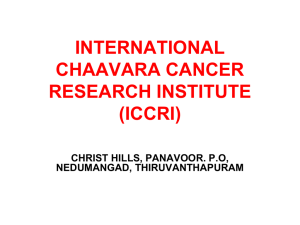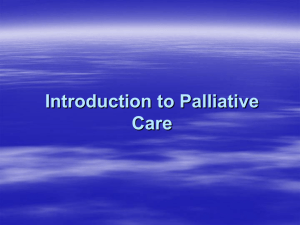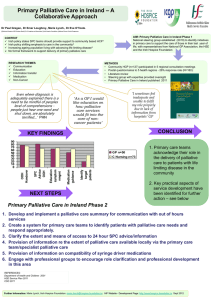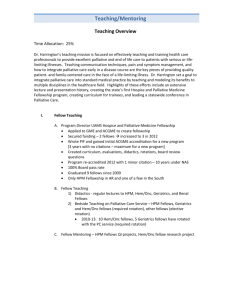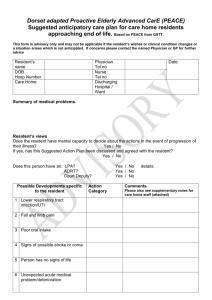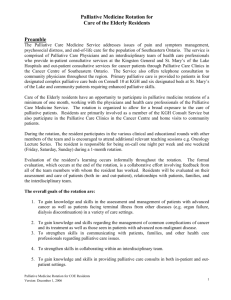Palliative Care - University of Manitoba
advertisement
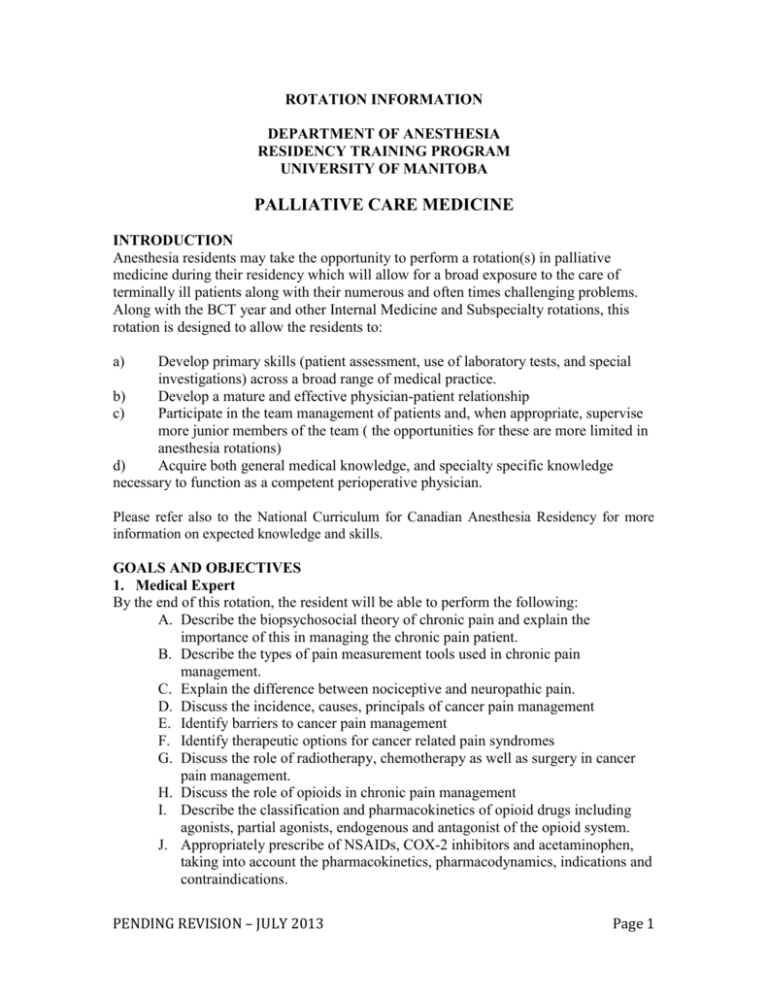
ROTATION INFORMATION DEPARTMENT OF ANESTHESIA RESIDENCY TRAINING PROGRAM UNIVERSITY OF MANITOBA PALLIATIVE CARE MEDICINE INTRODUCTION Anesthesia residents may take the opportunity to perform a rotation(s) in palliative medicine during their residency which will allow for a broad exposure to the care of terminally ill patients along with their numerous and often times challenging problems. Along with the BCT year and other Internal Medicine and Subspecialty rotations, this rotation is designed to allow the residents to: a) Develop primary skills (patient assessment, use of laboratory tests, and special investigations) across a broad range of medical practice. b) Develop a mature and effective physician-patient relationship c) Participate in the team management of patients and, when appropriate, supervise more junior members of the team ( the opportunities for these are more limited in anesthesia rotations) d) Acquire both general medical knowledge, and specialty specific knowledge necessary to function as a competent perioperative physician. Please refer also to the National Curriculum for Canadian Anesthesia Residency for more information on expected knowledge and skills. GOALS AND OBJECTIVES 1. Medical Expert By the end of this rotation, the resident will be able to perform the following: A. Describe the biopsychosocial theory of chronic pain and explain the importance of this in managing the chronic pain patient. B. Describe the types of pain measurement tools used in chronic pain management. C. Explain the difference between nociceptive and neuropathic pain. D. Discuss the incidence, causes, principals of cancer pain management E. Identify barriers to cancer pain management F. Identify therapeutic options for cancer related pain syndromes G. Discuss the role of radiotherapy, chemotherapy as well as surgery in cancer pain management. H. Discuss the role of opioids in chronic pain management I. Describe the classification and pharmacokinetics of opioid drugs including agonists, partial agonists, endogenous and antagonist of the opioid system. J. Appropriately prescribe of NSAIDs, COX-2 inhibitors and acetaminophen, taking into account the pharmacokinetics, pharmacodynamics, indications and contraindications. PENDING REVISION – JULY 2013 Page 1 K. Identify and manage the side effects of NSAIDs, COX-2 inhibitors and acetaminophen L. Utilize antidepressants for pain management, taking into consideration the indication for use, the specific drugs used for the treatment of pain, principles of dosing antidepressants, and contraindications to different antidepressants. M. Appropriately prescribe anticonvulsants in the treatment of pain taking into account indications, the relative efficacy and adverse effects, and the appropriate dosing regimens for each anticonvulsant and potential toxicities of these drugs. N. Discuss the roles and indications of the following adjuvant drugs in the treatment of cancer pain: neuroleptics, antihistamines, analeptics, corticosteroids, muscle relaxants/antispasticity drugs, NMDA antagonists, local anesthetics and membrane stabilizing drugs, sympatholytic drugs, bisphosphonates and alpha-2 agonists. O. Discuss peripheral stimulation techniques used to produce analgesia including TENS, and acupuncture, including the postulated mechanisms of peripheral stimulation-induced analgesia. P. Discuss the role of local anesthetic/neurolytic nerve blocks in cancer pain management. Q. Discuss the role of surgical procedures in the management of pain including: peripheral neurectomy, sympathectomy, spinal dorsal rhizotomy, cordotomy, dorsal root entry zone procedures, commissural myelotomy, and facet rhizolysis. R. Appropriately prescribe and administer neuraxial opioids taking into consideration the indications, contraindications, side effects, and relative differences between opioids. S. Manage the following symptoms, and provide a rationale based in the pathophysiology of the symptoms and associated syndromes i. Dyspnea ii. Delirium iii. Nausea and vomiting iv. Constipation v. Anxiety and depression vi. Decubitus ulcers T. Diagnose and manage the following intercurrent medical problems in the palliative patient and provide a rationale based on the pathophysiology i. Hypercalcemia ii. Spinal cord compression iii. SVC syndrome iv. Pathologic fractures v. Seizures vi. hemorrhage: 2. Communicator A. Obtain a history that identifies i. The sources and types of pain and adverse symptoms, impediments to treatment, and biopsychosocial impacts PENDING REVISION – JULY 2013 Page 2 3. 4. 5. 6. 7. ii. All of the medical, surgical and biopsychosocial issues facing the individual patient B. Inform patients and families about therapies, options, the current and projected course of their illness in a manner that minimizes psychological distress C. Obtain informed consent for all treatments undertaken D. Establish and effective therapeutic relationships with patients and families E. Clearly determine the wishes of the patient with respect to degrees of intervention as illness progresses F. Recognize and coordinate access to support for bereavement and grief in patients in families Collaborator A. Identify the need for and coordinate access to psychological and spiritual support in the management of the palliative care patient. B. Identify the roles of, and coordinate access to medical and surgical consultants, allied health, rehabilitation services, and complementary medicine C. Liaise effectively with referring physicians, allied health professionals, and consultants D. Contribute as a member and leader, to multidisciplinary care rounds Manager A. Coordinate access to psychological support, physiotherapy, occupational therapy and other allied health services as needed B. Recognize and manage the challenges of home and outpatient management of palliative care Health Advocate A. Identify and intervene to address systemic impediments to provision of safe and effective, patient-centered palliative care Scholar A. Apply principles of evidence-based practice to palliative care Professional A. Adhere to all professional expectations as outlined in the overall program Goals and Objectives CLINICAL RESPONSIBLITIES Ward management The resident will be expected to take a leading role in the organization and function of the care team, as well as function as the primary physician for patients assigned to him/her. The details of schedules and locations will vary with the site assignment and will be handed out separately. Pain and Symptom Clinics The resident will be expected to attend all Pain and Symptom clinics. OTHER RESPONSIBILITIES Journal Club PENDING REVISION – JULY 2013 Page 3 The Resident is expected to attend all of the twice weekly journal club meetings that occur during their rotation The Resident will review and present at least one article at a journal club meeting over the course of the rotation Palliative Care Rounds The resident is expected to attend weekly Palliative care rounds. PENDING REVISION – JULY 2013 Page 4


